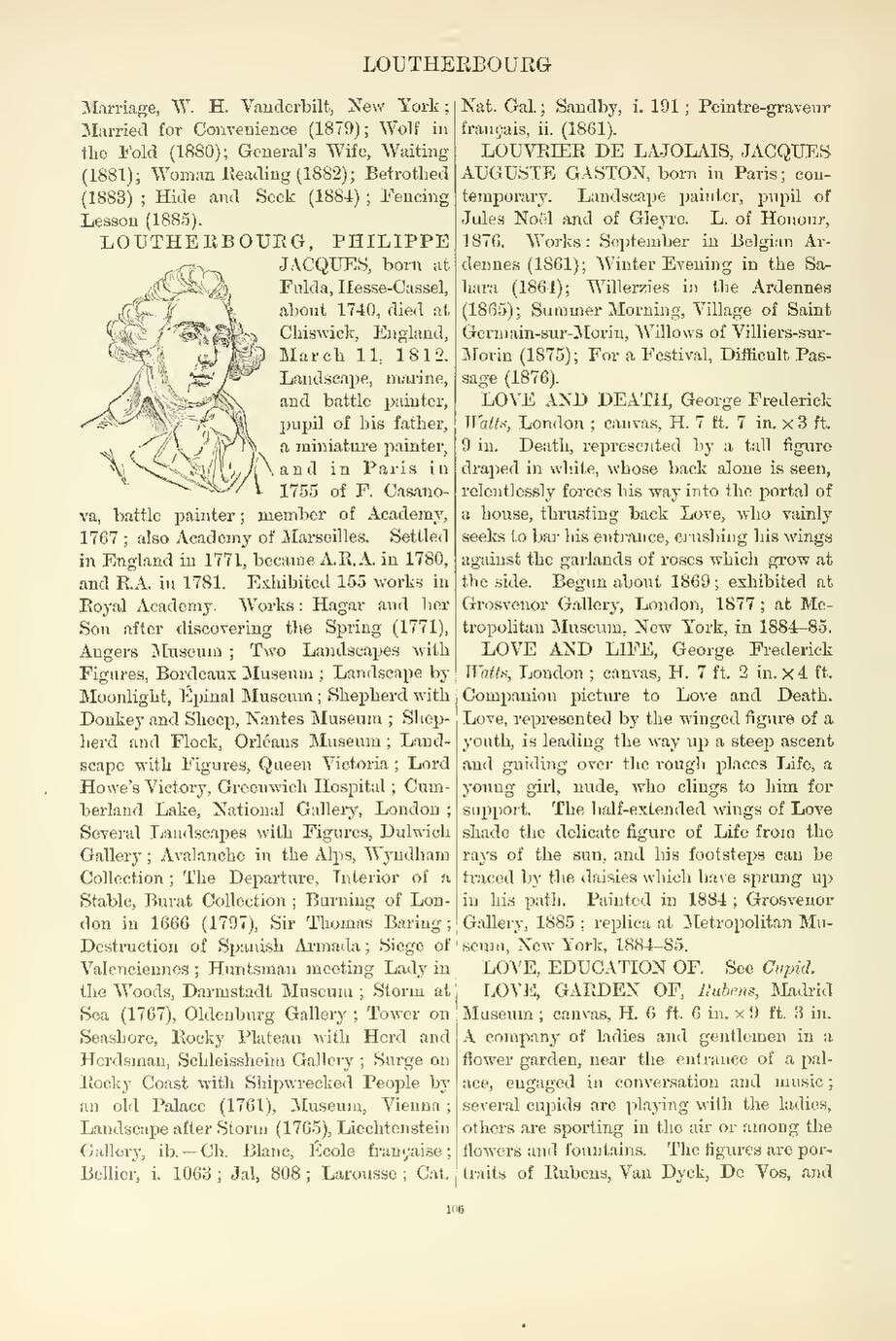Marriage, W. H. Vanderbilt, New York; Married for Convenience (1879); Wolf in the Fold (1880); General's Wife, Waiting (1881); Woman Reading (1882); Betrothed (1883); Hide and Seek (1884); Fencing Lesson (1885).
An image should appear at this position in the text. To use the entire page scan as a placeholder, edit this page and replace "{{missing image}}" with "{{raw image|Cyclopedia of painters and paintings (IA cyclopediaofpain03cham).pdf/128}}". Otherwise, if you are able to provide the image then please do so. For guidance, see Wikisource:Image guidelines and Help:Adding images. |
LOUTHERBOURG, PHILIPPE
JACQUES, born at
Fulda, Hesse-Cassel,
about 1740, died at
Chiswick, England,
March 11, 1812.
Landscape, marine,
and battle painter,
pupil of his father,
a miniature painter,
and in Paris in
1755 of F. Casanova,
battle painter; member of Academy,
1767; also Academy of Marseilles. Settled
in England in 1771, became A.R.A. in 1780,
and R.A. in 1781. Exhibited 155 works in
Royal Academy. Works: Hagar and her
Son after discovering the Spring (1771),
Angers Museum; Two Landscapes with
Figures, Bordeaux Museum; Landscape by
Moonlight, Épinal Museum; Shepherd with
Donkey and Sheep, Nantes Museum; Shepherd
and Flock, Orléans Museum; Landscape
with Figures, Queen Victoria; Lord
Howe's Victory, Greenwich Hospital; Cumberland
Lake, National Gallery, London;
Several Landscapes with Figures, Dulwich
Gallery; Avalanche in the Alps, Wyndham
Collection; The Departure, Interior of a
Stable, Burat Collection; Burning of London
in 1666 (1797), Sir Thomas Baring;
Destruction of Spanish Armada; Siege of
Valenciennes; Huntsman meeting Lady in
the Woods, Darmstadt Museum; Storm at
Sea (1767), Oldenburg Gallery; Tower on
Seashore, Rocky Plateau with Herd and
Herdsman, Schleissheim Gallery; Surge on
Rocky Coast with Shipwrecked People by
an old Palace (1761), Museum, Vienna;
Landscape after Storm (1765), Liechtenstein
Gallery, ib.—Ch. Blanc, École française;
Bellier, i. 1063; Jal, 808; Larousse; Cat.
Nat. Gal.; Sandby, i. 191; Peintre-graveur
français, ii. (1861).
LOUVRIER DE LAJOLAIS, JACQUES
AUGUSTE GASTON, born in Paris; contemporary.
Landscape painter, pupil of
Jules Noël and of Gleyre. L. of Honour,
1876. Works: September in Belgian Ardennes
(1861); Winter Evening in the Sahara
(1864); Willerzies in the Ardennes
(1865); Summer Morning, Village of Saint
Germaīn-sur-Morin, Willows of Villiers-sur-Morin
(1875); For a Festival, Difficult Passage
(1876).
LOVE AND DEATH, George Frederick
Watts, London; canvas, H. 7 ft. 7 in. × 3 ft.
9 in. Death, represented by a tall figure
draped in white, whose back alone is seen,
relentlessly forces his way into the portal of
a house, thrusting back Love, who vainly
seeks to bar his entrance, crushing his wings
against the garlands of roses which grow at
the side. Begun about 1869; exhibited at
Grosvenor Gallery, London, 1877; at Metropolitan
Museum, New York, in 1884-85.
LOVE AND LIFE, George Frederick
Watts, London; canvas, H. 7 ft. 2 in. × 4 ft.
Companion picture to Love and Death.
Love, represented by the winged figure of a
youth, is leading the way up a steep ascent
and guiding over the rough places Life, a
young girl, nude, who clings to him for
support. The half-extended wings of Love
shade the delicate figure of Life from the
rays of the sun, and his footsteps can be
traced by the daisies which have sprung up
in his path. Painted in 1884; Grosvenor
Gallery, 1885; replica at Metropolitan Museum,
New York, 1884-85.
LOVE, EDUCATION OF. See Cupid.
LOVE, GARDEN OF, Rubens, Madrid
Museum; canvas, H. 6 ft. 6 in. × 9 ft. 3 in.
A company of ladies and gentlemen in a
flower garden, near the entrance of a palace,
engaged in conversation and music;
several cupids are playing with the ladies,
others are sporting in the air or among the
flowers and fountains. The figures are portraits
of Rubens, Van Dyck, De Vos, and
